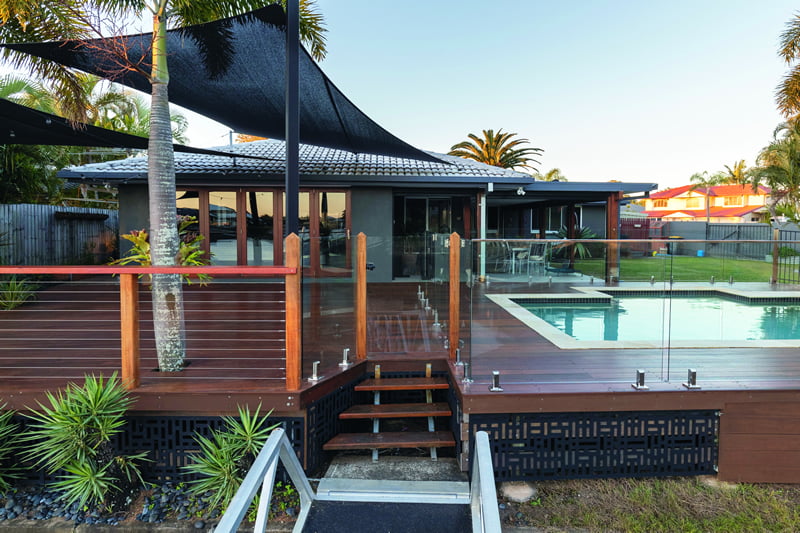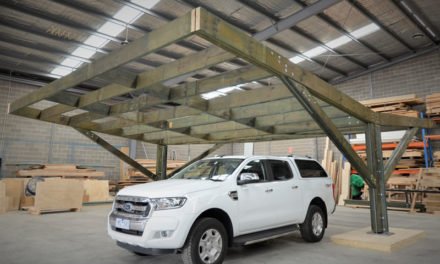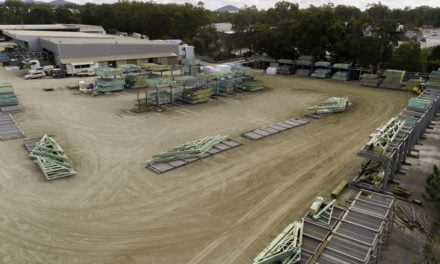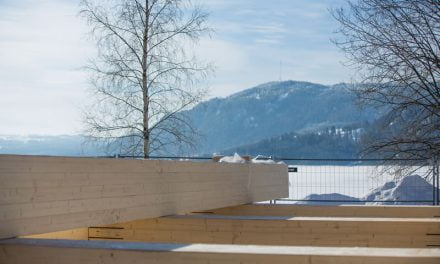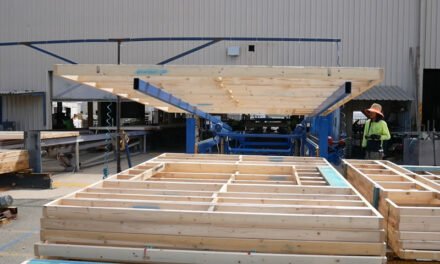Australians are happy to spend on decking timbers and treatments. We talk to the people behind some of the best new products, including timbers for areas you wouldn’t expect.
Getting out on the deck is a classic Australian ritual, from the kids playing, to dinner outside, to hanging out in a cool breeze on a hot evening. This year, given it looks like most of us are spending another summer close to home, decks are playing a more central role than ever in Aussie homes.
That’s great news for builders and for timber and hardware retailers: backyard makeovers and upkeep represent a reliable income stream, and a great chance to build ongoing relationships with customers.
Decks now are far more than the old red timber and merbau. Today, more customers select timbers by what’s appropriate to their location and conditions, with an eye to environmental concerns. Whether you’re a builder or a seller, here are some of the decking details that should be on your radar.
Treatment and timbers
The basics of using the right timbers in outdoor applications are almost universally understood in the market these days.
“Most people are pretty conscionable about what they sell to the market for external applications,” says Deeon Otto, managing director of Australian Timbers.
“The industry around Australia is full of conscionable traders who try to match the product to what’s needed: you can’t afford not to be because the liability outweighs the sale if you have to rectify a mistake. And there’s the reputational damage. We’re a company that’s almost 90 years old – it doesn’t take long to undo a reputation.”
So, walk into any timber retailer and you’ll hear salespeople directing tradies and the DIY set to H3 treated, or Class 2 durability or above for their decking timbers. But every now and then you’ll also hear someone arguing they don’t need that.
“Because people often know a name or a brand that they think they might want to use on a job, but it doesn’t match what they tell us about the job,” Otto says. “We try to match them with the correct product that will deliver longevity and be fit for purpose.”
Troy Justice at Arxada (formerly known as Lonza Wood Protection) has heard all the in-store tales from his supplier customers. “It’s a false economy wanting to save there, because the price difference for treated timber of any type is minuscule compared to the extended lifespan of the product,” he says. “When you talk to the homeowner, they’re usually more focused on performance or sustainability, rather than just cost.”
Sustainability has been a cornerstone of recent Arxada products popular in the decking market, particularly the Tanalith family of metal-based, water-borne preservatives.
Tanalith E uses a copper azole formulation in its anti-rot and insecticidal treatment, so is widely used for decking timbers thanks to its suitability for direct human contact. It’s approved for use on children’s play equipment and in schools and daycare centres.
Arxada has also recently re-introduced Tanalith Q, an alkaline copper quartenary product, which is popular for agricultural use but also suitable for decking. “We’ve heard from a lot of customers that they were concerned about end-of-life disposal,” Justice says. “It’s also one of the key issues we’ve been focused on at Arxada. Currently, only Queensland’s end-of-life code allows for Tanalith Q to be composted, but it is a very suitable disposal for timbers treated with that product and we hope other states will modify their regulatory approach to follow.”
The Tanacare Timbercoat premium decking oil rounds out the offer. A deep penetrating oil, it protects timbers from UV, water penetration, mould and algae and is designed to work perfectly with metal-based timber treatments as well as all other outdoor timber products.
Keeping up appearances
Alongside the appropriate timber, the right care will add years to a deck’s functional life and good looks, even in areas with harsh sun and rain – timber’s natural enemies.
“We’re seeing a lot of our customers adopting pre-oiling,” says Will Keaney, commercial marketing manager at Intergrain Trade & Industrial. The term covers both the industrial process done using machines like those from Danish brand Ceetec by timber suppliers to quickly and accurately deliver four-sided coverage, and the manual process of a person painting oil on in a domestic setting, less quickly, but still with the added benefit of protecting the deck’s underside.
“It makes sense for businesses, because they can offer a point of difference in their product and it delivers a lot of value for not a lot of cost,” Keaney says. “It also makes sense for end users, because it the pre-oiling delivers protection during construction: it doesn’t matter if there’s a patch of bad weather while your deck is being built. Once construction is finished, it just needs to be cleaned and have two or more coats of finish applied for full protection.
“There’s already been rapid growth for this process and we expect to see that continue. As pre-oiled timber becomes more and more popular in the Australian market, understanding of what it adds to the product will increase along the entire timber production and consumption pipeline.”
Intergrain has built strong relationships around pre-oiling (also called pre-coating), including with Coffs Harbour Hardwoods, a major NSW supplier that pre-oils with Intergrain’s new Universal Timber Oil. This ‘open system’ oil can be followed up with a water-based or solvent-based topcoat
Keaney is chuffed at the receptive welcome the product has had. “The beauty of Intergrain Universal Timber Oil is in its simplicity,” he says. “The intuitive protection message of ‘penetrates and nourishes to protect from within’ resonates with commercial, trade and residential customers. And, understandably, there’s a lot of love for the beautiful natural finish and simplified protection message.
“Sustainability is top of mind for timber producers and consumers these days and so we’re seeing more and more timber being specified – including on large-scale commercial projects. By delivering products that help these projects last at their best, we’re helping to encourage specifiers and architects to keep choosing timber and keep gaining all the environmental benefits that sustainably sourced timbers bring.
Beautiful and safe
Of course, not every deck is new. “I recently had a customer come to me after they bought a property in Newport, north of Brisbane,” says Stuart McLean, national specifications manager at Tenaru Timber & Finishes. “It’s a waterfront property with an existing deck around the pool that had previously had a non-slip finish applied and it needed rejuvenating.”
McLean took the meeting at the property. “It was such a good space, I offered to help do the job and make sure we got a really nice finish in exchange for being able to take some photos,” he says. “They wanted the timbers refreshed and then new glass fencing put in – which worked out well, because it was a lot easier to get an even finish without having to go through the fence!”
The job started with a full sanding done by a company that is also a Sikkens customer, so understood what McLean was asking for. They did a full sand across the boards that had cupped, then sanded lengthways with a finer grit of paper to get an even finish down the length of the boards.
“The old coating had some areas that were fairly weathered,” McLean says. “Taking it back to new grain gave us a nice bare substrate to start putting on a new system and made sure the finish would be consistent right across rather than re-coating and having different levels of colour and finish.
“It was such an improvement! You could see the difference a proper sand makes. Even the fasteners came up really well, just from the sanding.”
The next step was a coat of Sikkens Cetol HLSe, in Light Oak. “We chose that because it has just a little more pigment than some of the other options like Pine,” says McLean. “The pigment is what gives protection from the UV, which is particularly strong here, and aids in the longevity of the finish. It’s not too drastic a colour change, but it does an important job in keeping the coating from breaking down quickly.”
It being Queensland, it rained for two days before that first coat. “We made sure the timber was as dry as possible before we got a coat down,” McLean says. “Usually, we’d then leave that for 24 hours, but I gave it an extra day just to make sure. The HSLe is semi-permeable, so it could let any trapped moisture back out.
“After the first 24 hours, the first coat of HLSe had soaked into the timber and created a barrier, which would have protected it if the rain had come then. We find the coating starts curing and doing its job after the first 4-6 hours but recommend that if it does rain during that first day, you get out with socks, towels and a mop and get rid of any pooling water before it soaks into the timber.”
The second and third coats were Cetol Deck Slip Resistant finish. “A lot of non-slip systems ask you to add the non-slip component to the coating to achieve a slip rating,” says McLean. “That relies on someone getting the ratio right and the mixing right, especially when you’re looking at jobs that require an R11 or P4 slip rating.”
The Slip Resistant product has been independently tested against the current Australian Standard to ratings of both R11 and P4. Its grit is pre-incorporated and evenly dispersed throughout the coating so there are no clumps, using a coating technology that holds the grit in suspension.
“For a lot of the old non-slip products, there was an incredible amount of stirring required to mix the grit in,” McLean says. “On this job, I agitated the 20L can before I started the job, poured some into a roller tray and it was ready to go. When I needed to top up the tray, I gave the can three or four quick stirs with a paddle. I’m a sales rep, not a tradie, so if I can do a job like this and get a really good, even finish like the one we achieved, anyone can!
“When you say grit, it sounds abrasive, but it’s such a fine grit, it doesn’t feel rough underfoot, it just provides the resistance that’s required in public areas or around wet areas like this pool.”
The owners are very happy with the results. “It’s given the deck a new life and the glass fencing has opened it up for them as well” McLean says. “But the timber itself looks new. It shows you that you don’t have to replace decking; often you can give it a sand and expose really nice grain and get away with just re-coating.”
Prepare to succeed
From the timber and hardware industry’s perspective, the average person’s laziness when it comes to decking upkeep definitely works in our favour, but no one can say the information isn’t out there.
“We recommend inspecting coatings every 12 months at least and, when you see wear, apply another coat,” says McLean. “You don’t need to do a full sand for that, just a wash. Clean the deck with a mild detergent, let it all dry then get one or two more coats on. We’ve seen decks go 10-20 years without needing anything more than maintenance coats, depending on the UV exposure.”
Exposure makes a substantial difference: fully exposed areas might require annual maintenance coats then a full re-sand and re-coating every 8-10 years. Decks under cover might only need a maintenance coat every three to four years.
“For new decks, I think the preparation is key,” McLean says. “The biggest issue we see is that the timber has been coated too soon or had too little preparation, because the builder wants to get the coating on and get onto the next job.”
In the old days, new decks were left to weather for at least six weeks before coating, but those time frames aren’t viable now. “We’ve invented products that do jobs like stripping tannins from a new deck, because the timber comes a lot greener these days,” says McLean. “Using products like Sikkens Cetol BL Tannin & Oil Remover and the Sikkens BL Deck & Wood Cleaner will help you be able to coat your deck a lot sooner, and that coating will last. The initial cost isn’t much, it might be a 5L can of each, $200 maximum. Priced into a job, that’s nothing, especially compared to having to go back and rectify a job because the coating hasn’t lasted.
“I’d love to bag our competitors, but the truth is there are a lot of good products on the market and you can reliably expect major brands to last for the full period stated on the can. So if something is breaking down quickly, we always find out that comes down to preparation. Spending that extra day on prep will save you so much pain.”
Clever and adaptable
Not every timber needs treatment. Some of the Class 1 Durability hardwoods will still provide a long service life with no upkeep, and so does Thermory, a thermally modified timber brand from Estonia.
“We’ve been stocking Thermory for about two years, and we’re finding that as people become more aware of the product and its characteristics, it’s becoming more and more popular,” says Deeon Otto.
“In the environmental product sector, it rates very well, because its treatment comes from heat rather than adding chemicals, and plantation species are being used. But it’s the longevity of the timber that’s the real attraction. And the colour!”
Thermory’s heat treatment darkens the natural colour of each species. “The lighter the wood is, the more obvious the colour change is,” Otto says. “So pine, for example, becomes a fantastic caramel colour, whereas ash becomes darker again. In some cases, it’s the basis of the product being chosen for its aesthetic qualities by our specifier architects.
“That colour can be preserved by oils, but people are also attracted to the colour of the ash in particular as it silvers. For most timbers, people need to keep them oiled to preserve them, but with Thermory, you can leave it and have it change colour if you like without impacting the durability. So it’s particularly appropriate for decks that aren’t going to get regular TLC.”
Australian Timbers was recently approached to supply for a job in a South Australian coastal area. “The client was looking for a timber that would have durability and would silver to a soft, grey driftwood look while staying strong,” says Otto. “The tradesman on that job asked if there was a timber we could offer and the Thermory decking product both met the client’s wishes and brought the strength we knew the job would require.”
Australian Timbers stocks a range of Thermory products, including cladding, screening and other applications as well as decking. At the moment, decking is the strongest seller, but Otto is seeing the whole brand pick up. “As people’s awareness of the Thermory decorative range grows, particularly the Ignite and the Drift products, people are starting to look at using the claddings in feature applications, like garage doors or bulkheads or areas around windows,” he says. “A lot of our customer enquries are coming from commercial customers, including shopping centres and cellar doors for wineries. That’s where we’ve started working more closely with architects, so that popularity starts to drive sales for us.”
Thermory’s strong environmental credentials carry weight in the South Australian market. “Timber is a green product anyway, coming from sustainable sources and locking up carbon, but this is just a step beyond,” Otto says. “It comes from plantations that are consistently replanted and then it’s enhanced using a treatment that’s equally ‘green’. It works well beside the environmental concerns of many of our wineries and specifiers.”
For such a well-matched relationship, it began with serendipity. “We get five approaches a week via email from all around the world,” says Otto. “Obviously with a name like ‘Australian Timbers,’ we’re high up the list alphabetically. I read every one of those approaches. After reading the approach from Thermory, I talked to our manager Gavin and I said, ‘I think this product has merit.’ We investigated further and discovered that the thermo-treated timber had a great reputation and so we took the opportunity.”
There have been some issues with supply, thanks to the US market boom. Otto was unable to source his most popular size of Thermory timber at the start of the year. “We just went with a slightly different size – our customers understand that there are a lot of supply issues this year. Meanwhile, Thermory upped their production, so we now have that size back, despite initially expecting it not to be available till 2022.”
BAL 40 timber
One area where timber has not in the past been able to gain traction in Australia was in bushfire-prone areas. Now, a partnership between New Zealand’s Wood Modification Technologies and ITI Australia is set to change everything with its FLAMEfixx dFx product, which has just achieved BAL 40 rating at Warringtonfire.
“It’s a game-changing product,” says Andrew Dunn, CEO of the Timber Development Association. “ITI spent a lot of time chasing BAL 29, and it was expected the timber’s performance would peak around there. It overshot it so much that ITI investigated how it would perform in BAL 40, which was an area we didn’t expect it to reach – we normally don’t discuss timber for those zones. They’ve now tested it at BAL 40 and it’s passed with flying colours.”
The FLAMEfixx timber is just radiata pine, but the revolutionary dFx treatment combines an H3 preservative and fire retardant into a single solution. “It’s pressure impregnated, not a coating product,” Dunn says. “It has all the benefits we’ve been chasing in a product for bushfire areas for about 20 years, so someone now coming through with a product that does the job is great to see.”
Craig Davies, NSW manager at ITI Australia, is pleased to hear the praise. “We kept Andrew in the loop all the way through as he has a very, very good understanding of Australian bushfire standards, because he helped write them,” he says.
“We don’t have real-world case studies yet, because we’ve been lucky and not had any bushfires for 18-odd months. But in the testing we’ve done at Warringtonfire, the product does not ignite. It just carbonises. The Warringtonfire team were very impressed with it. Especially when we recently achieved BAL 40 for weatherboards, structural timbers and decking. It’s the first and only combustible product to ever achieve that. We got to watch it via video online while they were doing the testing and it was just incredible. It simply didn’t ignite.”
Warringtonfire is a fully accredited testing facility in Victoria. For the test, they build a wall from the weatherboard, or decks from the decking and joists and bearers from the structural timber. Davies says, “They have what they call cribs that they set fire to and then they apply radiant heat, which is extremely hot, as though it’s the bushfire front with the heat and the wind, and there was no ignition, it just carbonised.”
Dunn is more modest about his involvement: “I helped the team a bit with their processes, just making sure they were doing the right things along the way, which they have,” he says. “I was intrigued looking at the result of the testing: it doesn’t flame, just carbonises on the surface. That breaks down a little of the surface but it’s such a small impact, there’s no impact on it’s structural strength, just discolouration and maybe the smallest loss of mass.
“The thing with bushfires is that the exposure to the firefront is very short, it’s like passing your hand through the flame of a candle. In the tests they found the leading front of the board was the most discoloured, and I expect that will be the same in real-world fires, you might need to replace a few discoloured boards, but not the whole deck.”
FLAMEfixx has been on the market for over a year, releasing with its original BAL 29 rating. “Uptake is slower than I’d like,” says Davies, “but it’s coming along. At the moment it’s residential buildings that have bushfire levels imposed on them, so in NSW we’re selling in places the Black Summer fires impacted. They’re restricted on what they can use, so they’re welcoming the FLAMEfixx. Obviously there are questions, it’s early stages, but there’s a lot of information available on our website and in our brochures and from our sales team.“
Dunn sees the product’s applications reaching far beyond residential homes in bushfire areas. “It could be used for fire safety in tall buildings and things like that,” he says. “It’s a brilliant product. ITI has done the right thing. They spent a long time, 10 or 15 years getting it developed, so they’ve done all the work and double-dotted the i’s and double-crossed the t’s, as it were.
“Builders want to use wood, because they’re familiar with it. They don’t want to be using other non-combustible materials because people don’t like them. They’re too hot to walk on, or uncomfortable. They want the feel and the benefits of wood, so it’s great that we now have a product that can be used, and in applications beyond decking.”
For more, visit www.australiantimbers.com.au, https://flamefixx.com.au/, www.intergrain.com.au, www.arxadawoodprotection.com/apac/, https://tenaru.net.au/sikkens/product/ and www.thermory.com
Image: An existing deck north of Brisbane was given a major facelift with a full sand and some TLC from Sikkens. Courtesy Tenaru/Sikkens

